The Time Has Come for Digital Explosive Ordnance Risk Education
By Robin Toal [ MAG, Mines Advisory Group ]
CISR JournalThis article is brought to you by the Center for International Stabilization and Recovery (CISR) from issue 26.1 & 2 of The Journal of Conventional Weapons Destruction available on the JMU Scholarly Commons and Issuu.com
The increase in the number of civilian casualties from landmines and other explosive ordnance (EO) in recent years has driven the demand for new and innovative ways to provide communities with risk education. Additionally, with access limited by the COVID-19 pandemic, humanitarian organizations like MAG (Mines Adivsory Group) have had to adapt their approach, focusing on digital explosive ordnance risk education (EORE) to reach individuals and communities affected by EO.
MAG’s digital risk education project uses targeted social media ads to encourage safe behavior and teach communities how to identify and report EO to local authorities. The latest data on EO accident trends via the Information Management System for Mine Action (IMSMA) or national databases, plus real-time user engagement data via digital platforms, are used to inform agile strategies that can respond to changes and developments on the ground, ensuring messages reach high-risk regions and demographics.
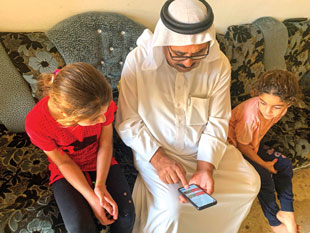
Abdulsalam Muhammed of Northeast Ninewa sharing risk education messages on
Facebook with his grandchildren. All images courtesy of the author/MAG.
Since 2019, MAG has piloted online risk education to encourage safe behaviors. In Ninewa, Iraq, the pilot—the first phase of the project—was the first time that risk education messaging was delivered on a large scale using Facebook ads. The results were promising, with ads shown twenty-nine million times to 983,447 people in Ninewa Governorate. Community liaison surveys showed that 94 percent of people surveyed in the community confirmed they saw the ads on Facebook and that the ads helped them understand the risks posed by EO.
Following the successful pilot in Iraq, MAG formed a partnership with the Office of Weapons Removal and Abatement in the US Department of State’s Bureau of Political-Military Affairs (PM/WRA) and Facebook to launch the second phase of the project. While the pilot project focused solely on areas of northern Iraq liberated from ISIS, phase two reached more than eleven million at-risk civilians in Iraq, Lebanon, Somalia, and Vietnam in 2021. The partnership expanded in 2022 to include Palestine (via the United Nations Mine Action Service) and Syria, while digital risk education was also delivered in Ukraine. These countries remain heavily contaminated by landmines, improvised explosive devices (IEDs), unexploded ordnance (UXO), and other EO that kill and maim civilians while also blocking economic development and the return of displaced communities.
Digital EORE
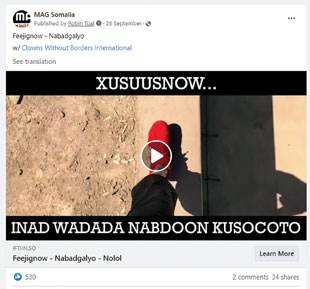
A short risk education video developed by Clowns Without Borders in the Maxa language for Somalia delivered using Facebook ads.
As digital EORE is a realitively new initiative, there is little data available on the efficacy and efficiency of using social media to impact change. MAG’s monitoring and evaluation (M&E) approach aims to provide context to the development and distribution of digital risk education materials, identify and provide recommendations to address barriers to access, measure communities’ knowledge of safe behaviors (pre-campaign), and determine the extent to which changes are seen by measuring understanding of safe behaviors (post-campaign). MAG gathered feedback on these activities through focus group discussions and a quantitative survey among community members before and after the project. Our team also circulated digital surveys with users who were shown ads online to capture comprehensive insights on the effectiveness of the initiative.
Social media is a competitive and congested environment where it is easy to scroll away from content that is not of interest or relevant to the user. Particularly in highly developed social media markets like Vietnam and Lebanon, content must be competitive among other ads. To maximize effectiveness in an
advertising-based social media space, digital risk education must present the issues realistically, engage users within the first few seconds, and deliver key messages promptly. By breaking up longer videos into shorter individual key messages, risk education practitioners can significantly increase the consumption of EORE materials, enhance awareness of the threat, deliver practical steps on how to stay safe, and provide guidance on how to report EO to relevant authorities. Alternatively, EORE image ads are effective at engaging with communities who have limited or expensive internet data and thus may be more suitable for communities living in remote and rural areas.
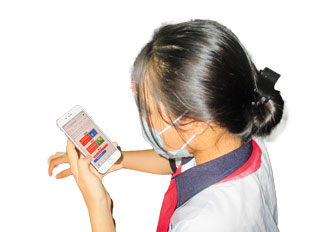
An 8th grade student at Hai Lam Primary and Secondary School, views risk education materials on her mobile phone.
In all country contexts, EORE video ads produced by the NGO Clowns Without Borders1 and videos of higher production value performed better. Animated ads worked best with young people, while live action videos were popular in all contexts where they were published. In most countries, users appeared to clearly understand the message of the ads, and 68 percent of beneficiaries surveyed recalled recently seeing one of the ads published by the project. Of respondents who recalled seeing an ad, 98 percent said that they had read the ad and/or clicked on the link, and 91 percent reported learning something from the ad. Beneficiaries’ level of confidence to report dangerous items to MAG or the national mine action authority rose after viewing the ads.
Gender and Local Environment. Additionally, to deliver effective digital EORE, it is recommended to invest in high-quality content that effectively engages users of both genders. MAG advocates for the integrated and systematic use of gender analysis at all stages of the project cycle. Digital risk education is designed with gender-sensitivity, inclusion, and participation as a core principle. Data from the first year of MAG’s digital risk education project revealed that girls and women tend to engage more with human faces and stories. As a result, and in order to boost interaction, MAG developed people-centric and beneficiary-based risk education content that reflects situations, landscapes, and people from their communities.
Traditional in-person risk education approaches can be limited or restricted entirely due to environmental and logistical barriers. Security considerations can prevent community liaison teams from accessing areas to deliver risk education, leaving EO-affected communities without support when they need it most. Weather, such as during monsoon seasons, can also restrict access and may become a greater problem as climate change triggers more extreme weather events.
Local community guidance and buy-in is needed to inform relevant and responsible choices about project and material design. In some contexts, community liaison staff that closely identify with the communities they serve enjoy increased access and higher engagement; however, digital approaches can reach communities regardless of liaison staff.
Benefits of Digital EORE. To engage groups unable to attend or for which in-person sessions are inaccessible, digital EORE content can reach platforms where they are already active. Digital EORE can also provide a lower-cost method of engaging target communities as it requires fewer human resources and has lower logistical costs. Social media advertising in particular can be a cost-effective method of engaging both large and niche communities.
Changes in technology have also served to better enable risk education practitioners to take control of the content development and distribution processes that increases speed and reduces costs. Graphic design, including video development, is now accessible to more people using simple and affordable software while tools to create and deliver messages and ads on social media is intuitive and easy to learn.
Developing a digital component to established EORE activities increases opportunities to engage with mine-affected communities. Additionally, digital content is more universally accessible to people with limited mobility as it can deliver messages to their home via their personal devices. Our materials tend to include subtitles and spoken word audio to enable people with sight or hearing impairments to engage with the materials. This approach complements in-person activities by providing accessible, lifesaving information and prioritizing key messages with traditional sessions. Digital EORE works best when there is human capacity and knowledge to integrate and complement existing activities and bridge the gap between the online and offline worlds.
Case Study: Equatorial Guinea
While digital EORE works best when supported by an active clearance capacity to remove the threat, it can also function as a stand-alone activity, and in some circumstances, may be the only way to engage with mine-affected communities. In March 2021, Bata, the largest city in Equatorial Guinea, was rocked by an explosion that killed 107 people and injured another 600. The explosion scattered EO across the city and up to 7 km from the blast site, causing significant damage to infrastructure.
The population of Bata were unfamiliar with the threat of EO and engaged in risk-taking activities such as taking selfies with items of scattered ordnance. Assessment teams observed civilians collecting and selling scrap metal and children playing in dangerous areas. The situation required an urgent response.
In coordination with UNICEF, the UN, and UNESCO, MAG rapidly developed Spanish language digital EORE materials and distributed them via Facebook ads to all users within 40 km of the blast site. Within six days of the explosion, digital EORE materials reached more than 18,000 individuals online, providing them with potentially lifesaving information.
“This new approach of delivering lifesaving lessons via Facebook ads in response to emergency scenarios ensures that we reach people affected by EO when they need it most, helping to reduce the risk of harm and keeping families safe. Digital channels enable us to get urgent warnings to affected communities when physical access is challenging.”
~ Sebastian Kasack, MAG Senior Community Liaison Advisor
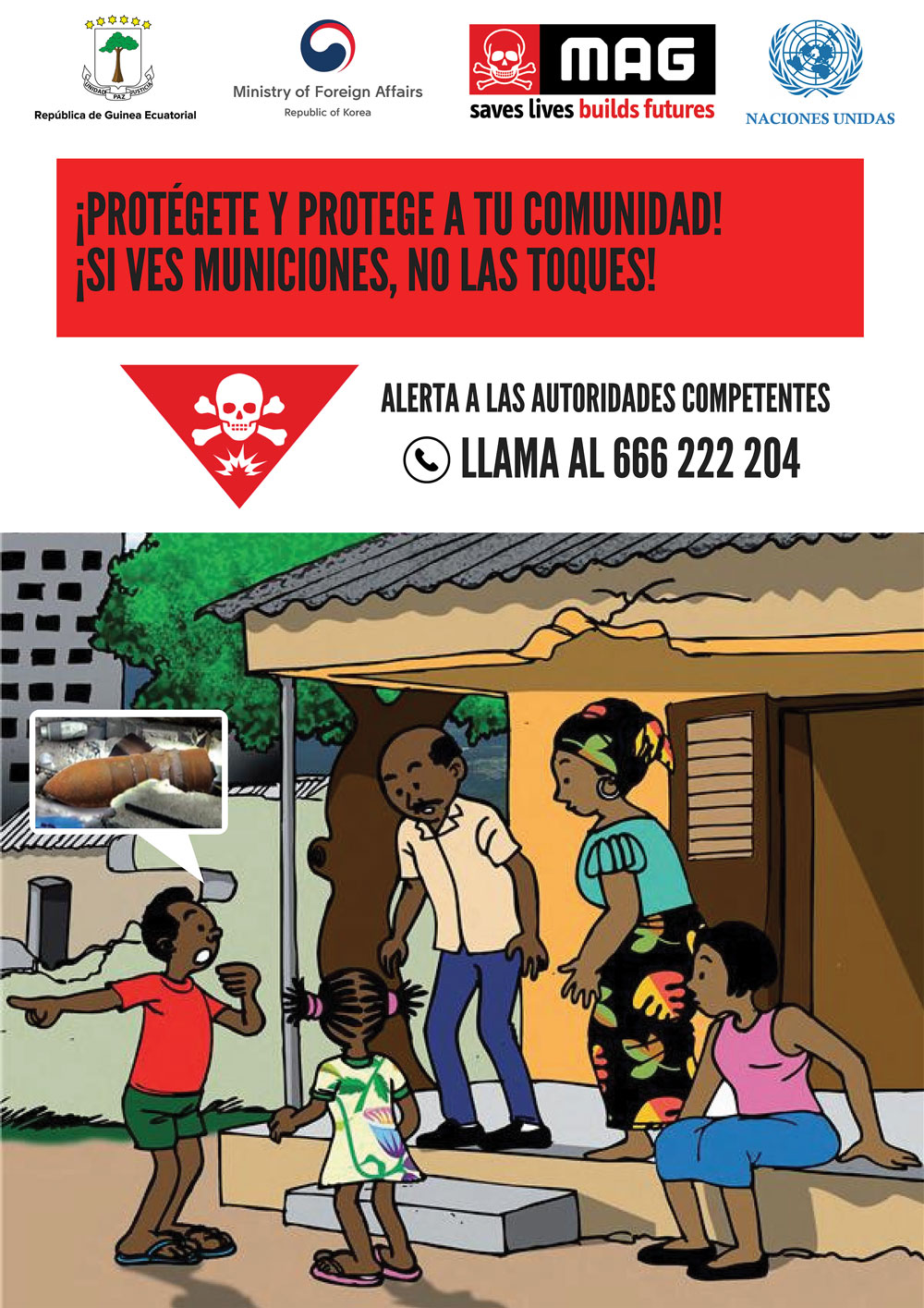
In Bata, Equatorial Guinea, MAG used digital technology to deliver emergency risk education.
Case Study: Sy Vietnam
Truong Van Sy, a twenty-three year-old computer technician, lives in Hoành Viễn village, Quàng Binh Province, with his parents, brother, his wife, and their daughter. Sy’s neighbor, at only thirty-five years-old, was a victim of an EO accident, killed in 2011 after stepping on a cluster bomblet.
Sy saw MAG’s EORE messages on his mobile phone in August and September 2021 and through these ads, found the EO reporting hotline number for Quảng Bình Province. He called the hotline number to report a BLU-26 submunition, which he discovered on the edge of his fish farm during cultivation some time ago but had not known how or who to call for help.
A year ago, I encountered a cluster bomblet while working in my family farm. At that time, I was very scared and nervous and didn’t know what to do. I left the area with the bomb untouched. Recently, many local people went into my land for picking mushrooms (and shooting birds) so I was really afraid that they might unfortunately step on the bomb that could endanger them. I always told everyone about the location of the bomb so people knew to avoid it.
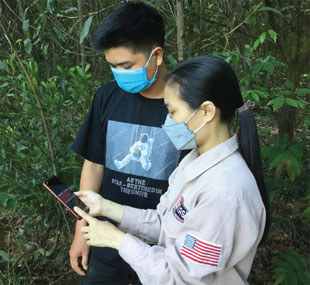
Sy and a MAG community liaison officer view the Facebook post that gave Sy the information on how to report the explosive ordnance he found on his land.
Sy and his family are all regular Facebook users. Sy has liked and followed MAG Vietnam’s Facebook page for updates.
I feel lucky to be able to know about MAG’s work and the EO reporting hotline number via MAG’s Facebook page so I can report the item. I hope that there will be more meaningful ads like these in the future so everyone knows how to call for help when an EO is found and knows how to avoid EO-related accidents as well.
Sy reported the cluster bomblet on 27 September 2021. MAG received the request from QB Mine Action Database and Coordination Unit and sent a community liaison team there to collect information the next day. MAG’s Multi-Task Team destroyed the bomb in situ on 30 September.
Sy said after the bomb was destroyed, “We feel safe now to work on the land.”
What’s Next?
MAG has established and integrated digital EORE into a number of programs, country strategies, and proposals to provide a sustainable platform for further development. In 2023, MAG will continue to develop digital EORE, including in Iraq, Lebanon, Palestine, Syria, Vietnam, and Ukraine, as well as developing digital provision to support small arms and light weapons (SALW) risk education. Similar to MAG’s approach with EORE, the purpose of SALW risk education will be to raise awareness of the threat of SALW and provide practical advice on how to reduce risks. Examples of practical SALW advice may include communicating the risks of firing your weapon into the air and safety reasons for securing weapons.
Emerging in the sector before the COVID-19 pandemic began in 2020, digital approaches became more important than ever as teams around the world were severely limited in performing in-person EORE. The Geneva International Centre for Humanitarian Demining’s (GICHD) Review of New Technologies and Methodologies for EORE in Challenging Contexts captured the growing number of activities across the humanitarian mine action (HMA) sector, which led to the creation of the Digital Task Team as an official offshoot of the EORE Advisory Group.2 Representatives from HMA organizations around the world regularly meet to develop strategies and best practices, and to formalize the initiative through a consistent monitoring and evaulation framework.
In May 2022, the first ever digital EORE workshop was hosted by UNICEF and GICHD in Switzerland. The workshop gathered around twenty EORE practitioners from across regions and organizations to take stock of tools, trends, successes, and gaps in digital programming both in EORE and other humanitarian aid sectors in order to strategically promote effective and ethical digital EORE in mine action. Participants drafted an action plan with short-, medium-, and long-term actions—many of which could fall under the scope of the Digital Task Team either through its existing subgroups or through the setup of new subgroups. Many HMA organizations are now active in delivering some form of digital EORE in countries on every continent.
Social media provides a new way to engage with communities in a dynamic and cost-effective manner. It enables us to reach large numbers of people in a specific area, overcoming obstacles posed by security, geography, and complex operating environments that limit the delivery of face-to-face risk education. The ability to target people based on specific criteria will ensure that we reach the most at-risk communities as well as groups that are harder to attract through “traditional” face-to-face sessions such as youth and young adults who are often the most difficult to reach.
MAG’s digital EORE work is generously supported by the US Department of State and Facebook.
 Robin Toal
Robin Toal
Digital EORE Manager
MAG, Mines Advisory Group
Robin Toal is Digital EORE Manager at MAG. He has fifteen years working in the humanitarian sector in project management, innovation, and behavior change, including the past ten years in humanitarian mine action with MAG and APOPO.

